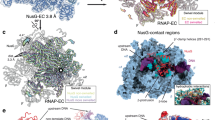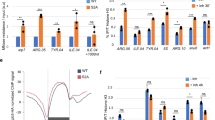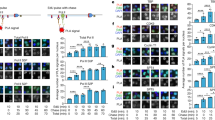Abstract
Upon transcription, histones can either detach from DNA or transfer behind the polymerase through a process believed to involve template looping. The details governing nucleosomal fate during transcription are not well understood. Our atomic force microscopy images of yeast RNA polymerase II–nucleosome complexes confirm the presence of looped transcriptional intermediates and provide mechanistic insight into the histone-transfer process through the distribution of transcribed nucleosome positions. Notably, we find that a fraction of the transcribed nucleosomes are remodeled to hexasomes, and this fraction depends on the transcription elongation rate. A simple model involving the kinetic competition between transcription elongation, histone transfer and histone-histone dissociation quantitatively explains our observations and unifies them with results obtained from other polymerases. Factors affecting the relative magnitude of these processes provide the physical basis for nucleosomal fate during transcription and, therefore, for the regulation of gene expression.
This is a preview of subscription content, access via your institution
Access options
Subscribe to this journal
Receive 12 print issues and online access
$189.00 per year
only $15.75 per issue
Buy this article
- Purchase on Springer Link
- Instant access to full article PDF
Prices may be subject to local taxes which are calculated during checkout






Similar content being viewed by others
References
Churchman, L.S. & Weissman, J.S. Nascent transcript sequencing visualizes transcription at nucleotide resolution. Nature 469, 368–373 (2011).
Subtil-Rodríguez, A. & Reyes, J.C. BRG1 helps RNA polymerase II to overcome a nucleosomal barrier during elongation, in vivo. EMBO Rep. 11, 751–757 (2010).
Gaykalova, D.A. et al. A polar barrier to transcription can be circumvented by remodeler-induced nucleosome translocation. Nucleic Acids Res. 39, 3520–3528 (2011).
Thiriet, C. & Hayes, J.J. Replication-independent core histone dynamics at transcriptionally active loci in vivo. Genes Dev. 19, 677–682 (2005).
Thiriet, C. & Hayes, J.J. Histone dynamics during transcription: exchange of H2A/H2B dimers and H3/H4 tetramers during pol II elongation. Results Probl. Cell Differ. 41, 77–90 (2006).
Dion, M.F. et al. Dynamics of replication-independent histone turnover in budding yeast. Science 315, 1405–1408 (2007).
Kimura, H. & Cook, P.R. Kinetics of core histones in living human cells little exchange of H3 and H4 and some rapid exchange of H2B. J. Cell Biol. 153, 1341–1353 (2001).
Schwabish, M.A. & Struhl, K. Asf1 mediates histone eviction and deposition during elongation by RNA polymerase II. Mol. Cell 22, 415–422 (2006).
Jamai, A., Imoberdorf, R.M. & Strubin, M. Continuous histone H2B and transcription-dependent histone H3 exchange in yeast cells outside of replication. Mol. Cell 25, 345–355 (2007).
Workman, J.L. Nucleosome displacement in transcription. Genes Dev. 20, 2009–2017 (2006).
Studitsky, V.M., Clark, D.J. & Felsenfeld, G. A histone octamer can step around a transcribing polymerase without leaving the template. Cell 76, 371–382 (1994).
Studitsky, V.M., Kassavetis, G.A., Geiduschek, E.P. & Felsenfeld, G. Mechanism of transcription through the nucleosome by eukaryotic RNA polymerase. Science 278, 1960–1963 (1997).
Clark, D.J. & Felsenfeld, G. A nucleosome core is transferred out of the path of a transcribing polymerase. Cell 71, 11–22 (1992).
Kireeva, M.L. et al. Nucleosome remodeling induced by RNA polymerase II loss of the H2A–H2B dimer during transcription. Mol. Cell 9, 541–552 (2002).
Kulaeva, O.I., Hsieh, F.K. & Studitsky, V.M. RNA polymerase complexes cooperate to relieve the nucleosomal barrier and evict histones. Proc. Natl. Acad. Sci. USA 107, 11325–11330 (2010).
Walter, W., Kireeva, M.L., Studitsky, V.M. & Kashlev, M. Bacterial polymerase and yeast polymerase II use similar mechanisms for transcription through nucleosomes. J. Biol. Chem. 278, 36148–36156 (2003).
Hodges, C., Bintu, L., Lubkowska, L., Kashlev, M. & Bustamante, C. Nucleosomal fluctuations govern the transcription dynamics of RNA polymerase II. Science 325, 626–628 (2009).
Kulaeva, O.I. et al. Mechanism of chromatin remodeling and recovery during passage of RNA polymerase II. Nat. Struct. Mol. Biol. 16, 1272–1278 (2009).
Kulaeva, O.I. & Studitsky, V.M. Mechanism of histone survival during transcription by RNA polymerase II. Transcr. 1, 85–88 (2010).
Izban, M.G. & Luse, D.S. Transcription on nucleosomal templates by RNA polymerase II in vitro: inhibition of elongation with enhancement of sequence-specific pausing. Genes Dev. 5, 683–696 (1991).
Bednar, J., Studitsky, V.M., Grigoryev, S.A., Felsenfeld, G. & Woodcock, C.L. The nature of the nucleosomal barrier to transcription direct observation of paused intermediates by electron cryomicroscopy. Mol. Cell 4, 377–386 (1999).
Walter, W. & Studitsky, V.M. Facilitated transcription through the nucleosome at high ionic strength occurs via a histone octamer transfer mechanism. J. Biol. Chem. 276, 29104–29110 (2001).
Kireeva, M.L. et al. Nature of the nucleosomal barrier to RNA polymerase II. Mol. Cell 18, 97–108 (2005).
Bondarenko, V.A. et al. Nucleosomes can form a polar barrier to transcript elongation by RNA polymerase II. Mol. Cell 24, 469–479 (2006).
Luse, D.S., Spangler, L.C. & Újvári, A. Efficient and rapid nucleosome traversal by RNA polymerase II depends on a combination of transcript elongation factors. J. Biol. Chem. 286, 6040–6048 (2011).
Lowary, P.T. & Widom, J. New DNA sequence rules for high affinity binding to histone octamer and sequence-directed nucleosome positioning. J. Mol. Biol. 276, 19–42 (1998).
Rivetti, C. & Codeluppi, S. Accurate length determination of DNA molecules visualized by atomic force microscopy: evidence for a partial B- to A-form transition on mica. Ultramicroscopy 87, 55–66 (2001).
Gnatt, A.L., Cramer, P., Fu, J., Bushnell, D.A. & Kornberg, R.D. Structural basis of transcription: an RNA polymerase II elongation complex at 3.3 A resolution. Science 292, 1876–1882 (2001).
Cramer, P., Bushnell, D.A. & Kornberg, R.D. Structural basis of transcription: RNA polymerase II at 2.8 angstrom resolution. Science 292, 1863–1876 (2001).
Eickbush, T.H. & Moudrianakis, E.N. The histone core complex: an octamer assembled by two sets of protein-protein interactions. Biochemistry 17, 4955–4964 (1978).
Park, Y.J., Dyer, P.N., Tremethick, D.J. & Luger, K. A new fluorescence resonance energy transfer approach demonstrates that the histone variant H2AZ stabilizes the histone octamer within the nucleosome. J. Biol. Chem. 279, 24274–24282 (2004).
Wittmeyer, J., Saha, A. & Cairns, B. DNA translocation and nucleosome remodeling assays by the RSC chromatin remodeling complex. Methods Enzymol. 377, 322–343 (2004).
Luger, K., Mäder, A.W., Richmond, R.K., Sargent, D.F. & Richmond, T.J. Crystal structure of the nucleosome core particle at 2.8 Å resolution. Nature 389, 251–260 (1997).
Huang, J., Schlick, T. & Vologodskii, A. Dynamics of site juxtaposition in supercoiled DNA. Proc. Natl. Acad. Sci. USA 98, 968–973 (2001).
Jin, J. et al. Synergqstic action of RNA polymerases in overcoming the nucleosomal barrier. Nat. Struct. Mol. Biol. 17, 745–752 (2010).
Hsieh, F.K., Fisher, M., Újvári, A., Studitsky, V.M. & Luse, D.S. Histone Sin mutations promote nucleosome traversal and histone displacement by RNA polymerase II. EMBO Rep. 11, 705–710 (2010).
Bao, Y. et al. Nucleosomes containing the histone variant H2A.Bbd organize only 118 base pairs of DNA. EMBO J. 23, 3314–3324 (2004).
Belotserkovskaya, R. et al. FACT facilitates transcription-dependent nucleosome alteration. Science 301, 1090–1093 (2003).
Hayes, J.J. & Wolffe, A.P. Histones H2A/H2B inhibit the interaction of transcription factor IIIA with the Xenopus borealis somatic 5S RNA gene in a nucleosome. Proc. Natl. Acad. Sci. USA 89, 1229–1233 (1992).
Bruno, M. et al. Histone H2A/H2B dimer exchange by ATP-dependent chromatin remodeling activities. Mol. Cell 12, 1599–1606 (2003).
Kireeva, M.L., Lubkowska, L., Komissarova, N. & Kashlev, M. Assays and affinity purification of biotinylated and nonbiotinylated forms of double-tagged core RNA polymerase II from Saccharomyces cerevisiae. Methods Enzymol. 370, 138–155 (2003).
Zhang, Y. et al. DNA translocation and loop formation mechanism of chromatin remodeling by SWI/SNF and RSC. Mol. Cell 24, 559–568 (2006).
Thåström, A., Lowary, P.T. & Widom, J. Measurement of histone–DNA interaction free energy in nucleosomes. Methods 33, 33–44 (2004).
Rivetti, C., Guthold, M. & Bustamante, C. Scanning force microscopy of DNA deposited onto mica: equilibration versus kinetic trapping studied by statistical polymer chain analysis. J. Mol. Biol. 264, 919–932 (1996).
Acknowledgements
We thank M. Dangkulwanich, T. Ishibashi, B. Onoa, P. Visperas and Y. Wu for experimental assistance and helpful discussions, and C. Rivetti for sharing the ALEX code. This work was supported by the Howard Hughes Medical Institute and by US National Institutes of Health grant R01-GM032543-30 (to C.B.).
Author information
Authors and Affiliations
Contributions
L.B., M.Kopaczynska, C.H. and C.B. designed the research. M.Kopaczynska, L.B. and C.H. prepared materials and conducted experiments. L.B. and M.Kopaczynska analyzed the data. L.L. and M.Kashlev contributed materials and discussed the manuscript. L.B., M.Kopaczynska, C.H. and C.B. wrote the paper.
Corresponding author
Ethics declarations
Competing interests
The authors declare no competing financial interests.
Supplementary information
Supplementary Text and Figures
Supplementary Figures 1–4, Supplementary Tables 1–2 and Supplementary Discussion (PDF 347 kb)
Rights and permissions
About this article
Cite this article
Bintu, L., Kopaczynska, M., Hodges, C. et al. The elongation rate of RNA polymerase determines the fate of transcribed nucleosomes. Nat Struct Mol Biol 18, 1394–1399 (2011). https://doi.org/10.1038/nsmb.2164
Received:
Accepted:
Published:
Issue Date:
DOI: https://doi.org/10.1038/nsmb.2164
This article is cited by
-
A portable regulatory RNA array design enables tunable and complex regulation across diverse bacteria
Nature Communications (2023)
-
Atomic force microscopy-based approaches for single-molecule investigation of nucleic acid–protein complexes
Biophysical Reviews (2023)
-
Chromatin fibers stabilize nucleosomes under torsional stress
Nature Communications (2020)
-
Single-molecule characterization of extrinsic transcription termination by Sen1 helicase
Nature Communications (2019)
-
Histone octamer rearranges to adapt to DNA unwrapping
Nature Structural & Molecular Biology (2018)



